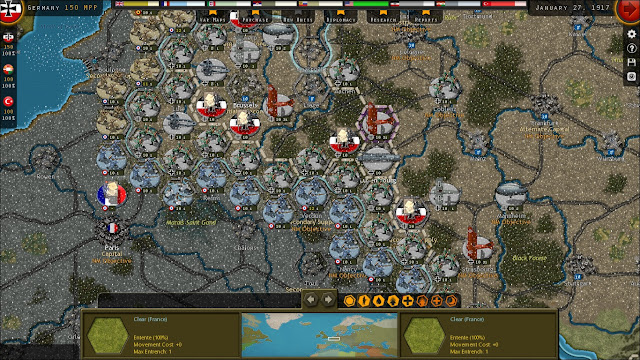Gameplay
Players are acting as the captain of two treasure-seeking ships, all of which start in the Harbour space. After setup, there will be a total of fourteen wreck sites randomly placed across the board that you and your opponents will have the opportunity to explore. The wreck sites are split into six basic and nine advanced wreck sites. Basic wrecks will start the game face up, so all players know which immediately accessible spots could be the most helpful. Advanced wrecks start face down and the game will end after four of the advanced wrecks have been revealed which contain the sunken city. |
| 4 player early game |
Each player starts with four starting crew cards in their hands and must play one or more cards each turn to commit an action (except resting which returns spent cards to your hand). Each crew card has icon(s) that dictate what that card can be used for. For example, crew cards with propeller icons allow you to sail, money icons allow you to recruit more crew; and then there are the oxygen, creature and gem icons which only are used when diving. After you’ve used any card it will go to your rest area on your player board.
 |
| All the icons |
Push your luck games tend to be multiplayer solitaire events without additional mechanics. In Deep Blue, the player interaction primarily comes when diving, although there is some during the recruit actions as well. When you take the Dive action, all other adjacent ships may rush to the wreck and ‘share’ in the spoils. After each gem pull, whether good or bad, each player in the dive can play cards to increase their reward, or prevent them surfacing early (and losing points).
 |
| A dive in progress |
As Dive Leader you will get an extra bonus and will likely score more victory points than other players. However, if you’re forced to surface early you will lose all the points that you would have got from the drawn gems. Players that are able to defend when the dive leader fails would still get the points from gems. Pushing when you have more defensive icons available than your opponents and knowing when to rest (often) is crucial for success. A well-played dive could net the dive leader over 50 points quite easily. However, the final scores for each player will likely be different due to the crew cards that they were able to play during the dive.
 |
| Quality components |
Components
Very little needs to be said here. The game’s components are all of excellent quality and I particularly like the little ship meeples. This is a simple family game and the cartoony artwork throughout reflects the typical family audience that this game would appeal to. The actions and particularly the icons the permit them are simple and easily understood. After two rounds any adult player will need no further guidance. |
| A well thought out insert |
Criticisms
The game is a little simple for my tastes and I think relies on luck just a little too much. There are obviously ways to mitigate bad luck (black and blue gems), but as you’re building a communal bag of gems throughout the game every other tactical player will be wanting the same crew to mitigate bad pulls or enhance good gems.There are no apparent scaling or rule changes for 2 or 5 player games. The board felt a bit empty with 2 players. In a 5 player game, there weren’t enough available defensive options and the crew deck seems to run out very quickly.
Conclusion
There’s an easy comparison to make with Quacks of Quedlinburg but this game is far simpler. I imagine this would make an ideal Christmas gift for a non-gamer family. It’s not that expensive and it plays quickly, if you’re stuck looking for a fun gift that may convince friends there’s fun to be had beyond the Christmas pain and suffering of Monopoly then this just may be that game. The rules are easily understood and I’ve even had a 6-year-old playing it. |
| The last sunken city tile |
There are some tactical decisions to be made, e.g. finish the dive early to deny your opponents even more points, keep pushing to exhaust cards, rushing to dives to move further into the advanced wreck sites etc. but there’s not really enough here to keep me coming back for more. The Captain’s Log cards do alter the gameplay and help to an extent but I didn’t find any of the rule alterations particularly interesting and I don’t think this will keep the attention of any gamers beyond one or two plays.
I’d like to thank Asmodee for sending out this review copy for the website.
Publisher: Days of Wonder
BGG Page: https://boardgamegeek.com/boardgame/283649/deep-blue
Players: 2 – 5
Designers: Daniel Skjold Pedersen & Asger Harding Granerud
Playing Time: 45 minutes































Follow Us